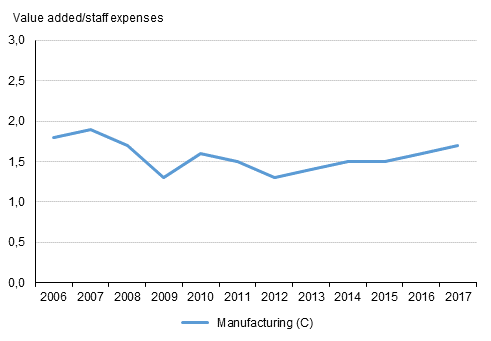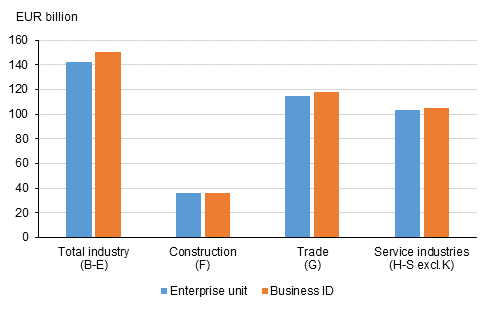Published: 18 December 2018
Personnel costs comprised 57 per cent of the value added in manufacturing in 2017
The total value added of manufacturing enterprises (TOL C) was EUR 29.6 billion. The value added generated was EUR 2.6 billion more than in the year before. Wages and salaries and other personnel expenses amounted to EUR 16.8 billion. Thus the relation between value added and personnel costs, that is, real productivity, was 1.7 in 2017. Real productivity in manufacturing has improved in recent years, but the level of the whole industry ten years ago has still not been reached. These data derive from Statistics Finland’s structural business and financial statement statistics.
Real productivity in manufacturing in 2006 to 2017

Real productivity describes how many EUR in value added is achieved with EUR one spent on personnel costs.
The number of personnel in manufacturing has declined from 2006 to 2017 by nearly one quarter. This corresponds to good 95,000 staff-years. In the corresponding time, wages and salaries and other employer contributions paid by enterprises have decreased by slightly over EUR 0.5 billion. The effect of these employment measures on the improvement of real productivity has remained quite modest, when correspondingly, the use of external manufacturing services has increased by EUR 1.6 billion from 2006.
Financial statement data with new statistical unit in 2017
In addition to financial statement data based on legal units (Business IDs), data by industry based on the enterprise unit are now published in the structural business and financial statement statistics. Data are available for the first time regarding the statistical year 2017.
The purpose of the enterprise unit is to describe financial entities instead of administrative structures. One or more enterprise units can be formed from the legal units (Business ID) of an enterprise group. For enterprises outside enterprise groups, the enterprise unit always corresponds to the legal unit. The enterprise unit corresponds to the smallest group of legal units, which in its decision-making process forms an independent production unit. The internal business transactions of the enterprise unit have been eliminated so the data by industry differ from the data based on legal units (Business ID). The differences are also due to the deduction of industry concerning enterprise units with multiple activities. The changes are most visible in operating income and expenses.
In the data based on enterprise unit, turnover in the entire non-financial corporations sector (TOL B to S, excl. K) was EUR 396 billion, which is EUR 12.6 billion less than the combined turnover for legal units in 2017.
Turnover of enterprises by enterprise unit and legal unit and industry in 2017

When enterprises’ activities are described by enterprise unit, the biggest changes are visible in all manufacturing (TOL B to E) and its sub-industries the forest industry and metal industry. In recent years, several internal sales companies of enterprise groups have been established in the forest industry. Their internal transactions have been eliminated by good EUR 5 billion.
The change to the use of enterprise unit is also visible in the key figures on the profitability by industry. When income and expenses are eliminated in equal measure, the percentages of business profits increase in the operating margin, for example.
Enterprises’ operating margin by enterprise unit and legal unit and industry in 2017
| Enterprise unit, Operating margin, per cent |
Business ID, Operating margin, per cent |
|
| Total industry (B-E) | 11,3 | 10,7 |
| Construction (F) | 8,5 | 8,5 |
| Trade (G) | 4,0 | 3,9 |
| Service industries (H-S excl.K) |
14,3 | 14,2 |
Number of personnel of enterprises grew in 2017
The number of legal units was 364,500 in total in 2017. Of these, 364,200 enterprise units were formed. The introduction of the enterprise unit only has a small effect on the number of personnel on the total level, but due to the reallocations of industries, small changes are visible in individual industries. In the following examination the effect of enterprise units is disregarded.
The number of personnel of enterprises grew by around 25,000 staff-years in 2017. The combined number of personnel was 1.45 million converted into full-time employees. The number of personnel rose most in the industries of computer programming, construction of buildings and employment activities (industries 62, 41 and 78). The number of personnel decreased most in retail trade and agriculture (industries 47 and 01).
The number of enterprises grew by around two per cent from the level of the previous year. The number of enterprises grew most in forestry and real estate activities (industries 02 and 68). The share of limited companies of all enterprises grew and their share surpassed 40 per cent in 2017. The share of own-account workers of all enterprises was still biggest, around 44 per cent. The shares of general and limited partnerships continued to decline.
The share of micro enterprises of all enterprises was biggest, around 92 per cent, but their share continued to decrease. A micro enterprise is defined as an independent enterprise with fewer than 10 employees.
The number of enterprises belonging to a group was under five per cent of the total number of enterprises, but the share of groups in the total number of personnel was over 54 per cent.
The data are based on the Tax Administration's tax data. The data have been supplemented with Statistics Finland's own inquiry.
Source: Statistics Finland
Inquiries: Pirkko Nurmela 029 551 3519, Jyri Järvinen 029 551 3562, rakenne.tilastot@stat.fi
Director in charge: Mari Ylä-Jarkko
Publication in pdf-format (225.2 kB)
- Tables
-
Tables in databases
Pick the data you need into tables, view the data as graphs, or download the data for your use.
Appendix tables
- Revisions in these statistics
-
- Revisions in these statistics (18.12.2018)
Updated 18.12.2018
Official Statistics of Finland (OSF):
Structural business and financial statement statistics [e-publication].
ISSN=2342-6233. 2017. Helsinki: Statistics Finland [referred: 15.12.2025].
Access method: http://stat.fi/til/yrti/2017/yrti_2017_2018-12-18_tie_001_en.html

